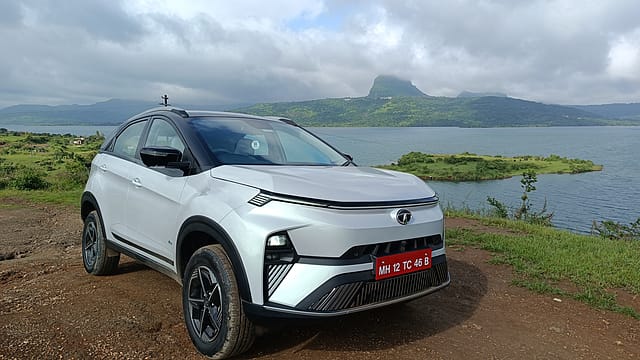Nexon.ev first drive review: India's top-selling EV gets a big upgrade
ADVERTISEMENT

In an electric car, the first thing that comes to mind is range. And despite the fact that Nexon.ev comes with a similar battery size as its predecessor, the facelift version promises a slightly higher range than the outgoing model.
Now, how is that possible? The carmaker has introduced a new electric motor which is 20 kilograms lighter. Tata Motors has also tried to make the car more aerodynamic by adding air curtains on the front bumper. The new LED elements reduce the Nexon.ev's total energy consumption on lighting by 30%, besides lending it a futuristic look.
The automaker has provided paddle shifters on the steering wheel to change the levels of regenerative braking. This handy feature increases range when you're driving in bumper-to-bumper traffic or going downhill where frequent braking is required.
In terms of performance, the second-generation motor is capable of spinning at 16,000 rpm compared with 12,000 rpm earlier. The electric vehicle sprints from 0-100 kilometre per hour in 9 seconds. Tata has also increased the maximum speed limit of the Nexon.ev to 150 kmph but driving it over 100 kmph is likely to drain the battery much faster.
On the exterior, the bonnet of the Nexon.ev takes cues from the Curvv concept. Tata has also made an effort to distinguish the Nexon.ev from the ICE Nexon facelift. The EV comes with a connected Daytime Running Lamp (DRL) which glows in different patterns during start and stop. The company is making both Nexon.ev and its ICE siblings on the same production lines.
December 2025
The annual Fortune 500 India list, the definitive compendium of corporate performance, is out. This year, the cumulative revenue of the Fortune 500 India companies has breached $2 trillion for the first time. Plus, find out which are the Best B-schools in India.
Coming back to the drive experience, I drove the white-coloured top variant which has been named 'Empowered Oxide'. When I started from Pune, the battery was 99% charged and showed a range of around 340 kilometres. My first stop was about 60 kilometres away near Pawna Lake. Once I reached there, the Nexon.ev still had 76% battery left and the 10.25-inch digital instrument cluster showed a range of 241 kilometres.
To test the handling and driving dynamics of the car on the hilly terrains of Western Ghats, I chose a narrow road from Pawna Lake to Aamby Valley City — the stretch was around 38 km. The highest regen level provided more stability during hill descent, besides increasing its range.
On my way back, I made a quick pit stop at Lonavala. After covering 95 kilometres on my return journey to Pune, the battery still had 37% of charge left and the instrument cluster was showing a range of 125 kilometres.
To be clear, the long-range 40.5 kilowatt-hour battery has an ARAI-certified range of 465 kilometres, which is 12 km more than the outgoing variant. The medium-range 30 kWh battery pack offers a range of 325 km.
Tata has now made the medium-range Nexon.ev compatible with a 7.2 kilowatt charger. However, Tata will not offer the 7.2 kW charger with the car. It can be purchased separately.
The carmaker claims the battery of Nexon.ev gets charged from 10% to 80% in 56 minutes while using a 50 kW fast charger. To be sure, the load-taking capacity of the battery is capped at around 30 kW to prevent overheating.
The estimated charging time from 10% state of charge (SOC) to 100% SOC from a 7.2 kW charger is 6 hours for the top trim and 4.3 hours for the medium-range variant.
The top variant comes with bi-directional charging features like vehicle-to-vehicle (V2V) charging and vehicle-to-load (V2L) charging. Through the V2V feature, the carmaker aims to target the close-knit EV owners' community in India who may want to help other EV owners in case they are stuck due to inadequate public charging infrastructure. The V2L charging feature can power appliances for loads up to 3.3 kVA.
The car comes with a slick monostable shifter, a 360-degree camera and a two-spoke steering wheel among other things. The instant cooling feature is quite useful in hot and humid weather and so are the ventilated leatherette seats.
In terms of safety, six airbags come as standard. There are seat belt reminders for all occupants. "With evolving global safety norms, side pole impact is extremely important, especially for electric vehicles because the battery is placed underneath. The Nexon.ev has been augmented for side pole crash as well," says Anand Kulkarni, chief product officer, Tata Passenger Electric Mobility. In 2018, Nexon had bagged a 5-star safety rating in the Global NCAP crash test.
The carmaker is offering a suite of apps called Arcade.ev app which can be used to watch movies or play games on the 12.3-inch infotainment screen while the car is getting charged.
The top variant of the Nexon.ev has a ground clearance of 190 mm compared with 205 mm in the medium-range trim. Due to a battery pack underneath, the floor of the backseat is a little raised in the top variant. Also, there are no pockets behind the front seatbacks.
Since its launch in 2020, Tata Motors has sold 53,000 Nexon electric vehicles, making it the top-selling EV in India. The top trim of the Nexon.ev will cost ₹19.94 lakh (ex-showroom) compared with ₹19.5 lakh for the outgoing model. The short-range base variant is priced at ₹14.74 lakh.
The ICE version of the Nexon has also seen an upgrade in terms of design and safety. I drove the top petrol variant that comes with a seven-speed dual-clutch transmission, which works smoothly. You also have an option to switch gears manually using the paddle shifter on the steering wheel. Even though the engine remains the same—a 1.2-litre three-cylinder turbo petrol—the DCT gearbox enhances the car's performance to a whole new level.
